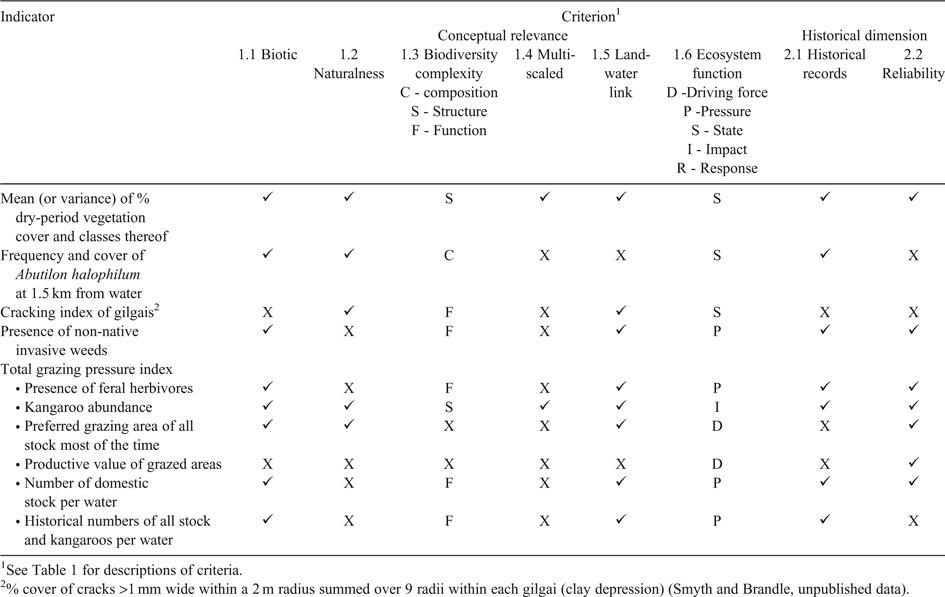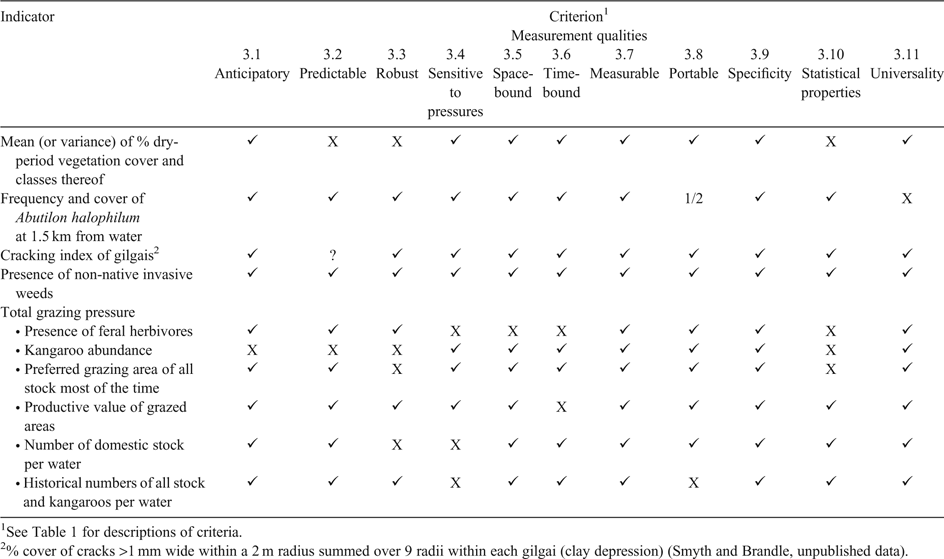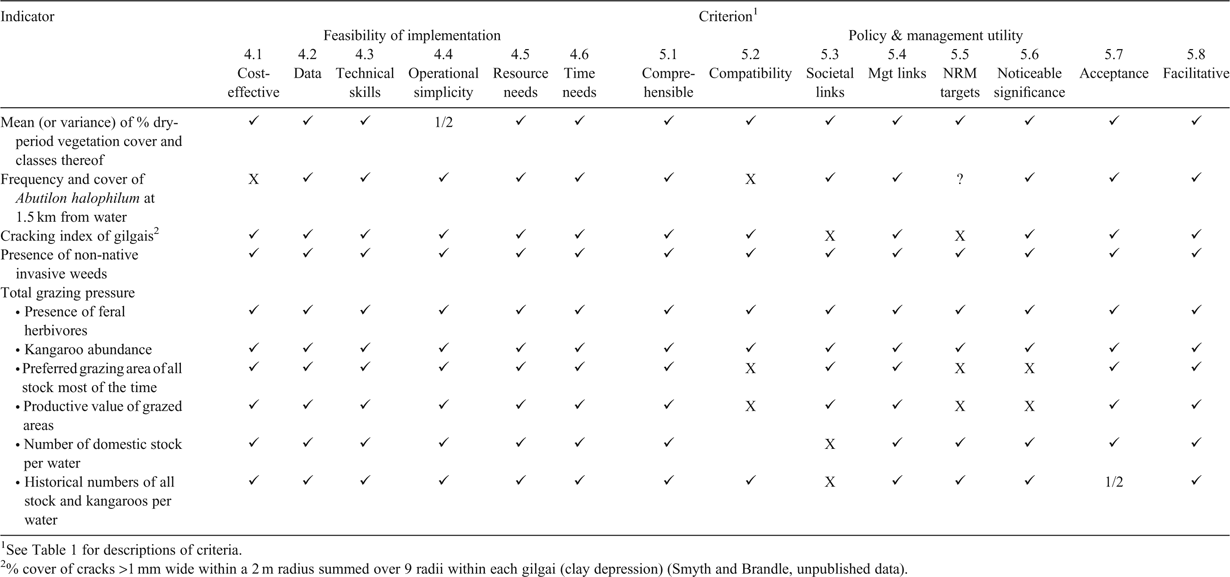A framework for assessing regional biodiversity condition under changing environments of the arid Australian rangelands
A. K. Smyth A F , R. Brandle B , V. Chewings C , J. Read D , A. Brook E and M. Fleming EA CSIRO Sustainable Ecosystems, PMB 2, Glen Osmond, SA 5064, Australia.
B Department for Environment and Heritage SA, GPO Box 1047, Adelaide, SA 5001, Australia.
C CSIRO Sustainable Ecosystems, PO Box 2111, Alice Springs, NT 0871, Australia.
D School of Earth and Environmental Sciences, The University of Adelaide, North Terrace, Adelaide, SA 5000, Australia.
E Department of Water, Land and Biodiversity Conservation, GPO Box 2834, Adelaide, SA 5001, Australia.
F Corresponding author. Email: anita.smyth@csiro.au
The Rangeland Journal 31(1) 87-101 https://doi.org/10.1071/RJ08047
Submitted: 11 September 2008 Accepted: 21 January 2009 Published: 26 March 2009
Abstract
Rangelands support many ecosystem services important to humans, including climate regulation. They also have a significant role to play in the mitigation of greenhouse gases. However, the capacity of any rangeland to do this depends foremost upon the condition of biodiversity, and the functioning of its ecosystems. Considerable research has been undertaken on rangeland condition but it has not yet included the assessment of biodiversity (plants, animals and microbes) as a primary focus. Rangeland managers have struggled to assess biodiversity condition because it is rarely defined, is everywhere (so what do you assess?), is always changing in response to natural and human disturbances (so how do you know when it has changed?) and what amount signals management action. Here we present a framework that addresses these issues, and apply it to select surrogates and indicators that are scientifically defensible in biological and planning terms for assessing biodiversity. An arid Australian rangeland region is used as a case study to develop and apply our approach. We were not able to illustrate interpretation of condition because of the absence of long-term monitoring data in Australian rangelands, but we do provide guiding principles about sampling design and analytical methods for interpretation that use raw data rather than multimetrics. We discovered that different management outcomes expected to be informed from assessing biodiversity condition affected surrogate and indicator choice, and that a number indicators were not robust when assessed on conceptual relevance, measurement qualities, feasibility of implementation and policy and management relevance for four different management outcomes. Our work highlights the importance of stating the expected outcomes of biodiversity condition assessments up front, so that indicators relevant to future management are chosen. It also shows that critical thought on the robustness of indicators is warranted, especially as condition assessments under climate change will require information on the functional traits of species. We conclude by assessing the strengths and weaknesses of our framework in relation to environmental planning.
Additional keywords: biodiversity monitoring, biodiversity and ecosystem functioning, biodiversity surrogacy, climate change, ecological indicators.
Acknowledgements
The Desert Knowledge Cooperative Research Centre, Alice Springs funded this work with in-kind from the Department of Water, Land and Biodiversity Conservation, the Department for the Environment and Heritage in South Australia, the South Australian Arid Lands NRM Board, Ecological Horizons Pty Ltd, The University of Adelaide and CSIRO. Dr Leigh Hunt (CSIRO) and two anonymous reviewers provided valuable feedback on the manuscript.
Andreasen J. K.,
O’Neill R. V.,
Noss R., Slosser N. C.
(2001) Considerations for the development of a terrestrial index of ecological integrity. Ecological Indicators 1, 21–35.
| Crossref | GoogleScholarGoogle Scholar |

Bastin G. N., Ludwig J. A.
(2006) Problems and prospects for mapping vegetation condition in Australia’s arid rangelands. Ecological Management & Restoration 7, S71–S73.
| Crossref | GoogleScholarGoogle Scholar |

Brown J. R., Thorpe J.
(2008) Rangelands and climate change: a synthesis and challenges. Rangelands 30, 52–53.
| Crossref | GoogleScholarGoogle Scholar |

Coulson D., Joyce L.
(2006) Indexing variability: a case study with climate change impacts on ecosystems. Ecological Indicators 6, 749–769.
| Crossref | GoogleScholarGoogle Scholar |

Crome F. H. J.,
Thomas M. R., Moore L. A.
(1996) A novel Bayesian approach to assessing impacts of rain forest logging. Ecological Applications 6, 1104–1123.
| Crossref | GoogleScholarGoogle Scholar |

Dale V. H., Beyeler S. C.
(2001) Challenges in the development and use of ecological indicators. Ecological Indicators 1, 3–10.
| Crossref | GoogleScholarGoogle Scholar |

Dale V. H., Polasky S.
(2007) Measures of the effects of agricultural practices on ecosystem services. Ecological Economics 64, 286–296.
| Crossref | GoogleScholarGoogle Scholar |

Dyksterhuis E. J.
(1949) Condition and management of range land based on quantitative ecology. Journal of Range Management 2, 104–115.
| Crossref | GoogleScholarGoogle Scholar |

Foran B. D.
(2007) Sifting the future from the past: a personal assessment of trends impacting the Australian Rangelands. The Rangeland Journal 29, 3–11.
| Crossref | GoogleScholarGoogle Scholar |

Fox D. R.
(2001) Environmental power analysis – a new perspective. Environmetrics 12, 437–449.
| Crossref | GoogleScholarGoogle Scholar |

Friedel M.
(1991) Range condition assessment and the concept of thresholds: a viewpoint. Journal of Range Management 44, 422–425.
| Crossref | GoogleScholarGoogle Scholar |

Friedel M.
(1994) How spatial and temporal scale affect the perception of change in the rangelands. The Rangeland Journal 16, 16–25.
| Crossref | GoogleScholarGoogle Scholar |

Gibbons P., Freudenberger D.
(2006) An overview of methods used to assess vegetation condition at the scale of site. Ecological Management & Restoration 7, S10–S17.
| Crossref | GoogleScholarGoogle Scholar |

Gibbons P.,
Zerger A.,
Jones S., Ryan P.
(2006) Mapping vegetation condition in the context of biodiversity conservation. Ecological Management & Restoration 7, S1–S2.
| Crossref | GoogleScholarGoogle Scholar |

Gray J. S., Brewers J. M.
(1996) Towards a scientific definition of the precautionary principle. Marine Pollution Bulletin 32, 768–771.
| Crossref | GoogleScholarGoogle Scholar |
CAS |

Hajkowicz S.
(2007) Allocating scarce financial resources across regions for environmental management in Queensland, Australia. Ecological Economics 61, 208–216.
| Crossref | GoogleScholarGoogle Scholar |

Havstad K. M.,
Peters D. P. C.,
Skaggs R.,
Brown J.,
Bestelmeyer B.,
Fredrickson E.,
Herrick J., Wright J.
(2007) Ecological services to and from rangelands of United States. Ecological Economics 64, 261–268.
| Crossref | GoogleScholarGoogle Scholar |

Hewitt J. E.,
Thrush S. E., Cummings V. J.
(2001) Assessing environmental impacts: effects of spatial and temporal variability at likely impact scales. Ecological Applications 11, 1502–1516.
| Crossref | GoogleScholarGoogle Scholar |

Hooper D. U.,
Chapin F. S.,
Ewel J. J.,
Hector A.,
Inchausti P.,
Lavorel S.,
Lawton J. H.,
Lodge D. M.,
Loreau M.,
Naeem S.,
Schmid B.,
Setala H.,
Symstad A. J.,
Vandermeer J., Wardle D. A.
(2005) Effects of biodiversity on ecosystem functioning: a consensus of current knowledge. Ecological Monographs 75, 3–35.
| Crossref | GoogleScholarGoogle Scholar |

Howe R. W.,
Regal R. R.,
Niemi G. J.,
Danz N. P., Hanowski J.
(2007) A probability-based indicator of ecological condition. Ecological Indicators 7, 793–806.
| Crossref | GoogleScholarGoogle Scholar |

Klein J. A.,
Harte J., Zhao X.-Q.
(2008) Decline in medicinal and forage species with warming is mediated by plant traits on the Tibetan Plateau. Ecosystems 11, 775–789.
| Crossref | GoogleScholarGoogle Scholar |

Knight A. T.,
Cowling R. M., Campbell B. M.
(2006) An operational model for implementing conservation action. Conservation Biology 20, 408–419.
| Crossref | GoogleScholarGoogle Scholar | PubMed |

Majer J. D., Beeston G.
(1996) The biodiversity integrity index: an illustration using ants in Western Australia. Conservation Biology 10, 65–73.
| Crossref | GoogleScholarGoogle Scholar |

Mampuku M.,
Yamanaka T.,
Uchida R.,
Fujii R.,
Maki T., Sakai H.
(2008) Changes in C3/C4 vegetation in the continental interior of the Central Himalayas associated with monsoonal paleoclimatic changes during the last 600 kyr. Climate Past 4, 1–9.

Morton S. R.,
Smith D. M. S.,
Friedel M. H.,
Griffin G. F., Pickup G.
(1995) The stewardship of arid Australia – ecology and landscape management. Journal of Environmental Management 43, 195–217.
| Crossref | GoogleScholarGoogle Scholar |

Neldner J.
(2006) Why is vegetation condition important to government? A case study from Queensland. Ecological Management & Restoration 7, S5–S7.
| Crossref | GoogleScholarGoogle Scholar |

Niemeijer D., de Groot R. S.
(2007) A conceptual framework for selecting environmental indicators sets. Ecological Indicators 8, 14–25.
| Crossref | GoogleScholarGoogle Scholar |

Niemi G. J., McDonald M. E.
(2004) Application of ecological indicators. Annual Review of Ecology, Evolution and Systematics 35, 89–111.
| Crossref | GoogleScholarGoogle Scholar |

Noss R. F.
(1990) Indicators for monitoring biodiversity: a hierarchical approach. Conservation Biology 4, 355–364.
| Crossref | GoogleScholarGoogle Scholar |

Osenberg C. W.,
Schmitt R. J.,
Holbrook S. J.,
Abu-Saba K. E., Flegal R.
(1994) Detection of environmental impacts: natural variability, effect size, and power analysis. Ecological Applications 4, 16–30.
| Crossref | GoogleScholarGoogle Scholar |

Pannell D. J.,
Marshall G. R.,
Barr N.,
Curtis A.,
Vanclay F., Wilkinson R.
(2006) Understanding and promoting adoption of conservation practices by rural landholders. Australian Journal of Experimental Agriculture 46, 1407–1424.
| Crossref | GoogleScholarGoogle Scholar |

Read J. L.
(2002) Experimental trial of Australian arid zone reptiles as early warning indicators of overgrazing by cattle. Austral Ecology 27, 55–66.
| Crossref | GoogleScholarGoogle Scholar |

Read J. L., Andersen A. N.
(2000) Using ants as early warning indicators: Responses to pulsed cattle grazing in the Australian arid zone. Journal of Arid Environments 45, 231–251.
| Crossref | GoogleScholarGoogle Scholar |

Read J. L.,
Kovac K.-J., Fatchen T. J.
(2005) ‘Biohyets’: a holistic method for demonstrating the extent and severity of environmental impacts. Journal of Environmental Management 77, 157–164.
| Crossref | GoogleScholarGoogle Scholar | PubMed |

Rodrigues A. S. L., Brooks T. M.
(2007) Shortcuts for biodiversity conservation planning: the effectiveness of surrogates. Annual Review of Ecology Evolution and Systematics 38, 713–737.
| Crossref | GoogleScholarGoogle Scholar |

Smyth A. K.,
Foulkes J., Watt A.
(2004) Biodivrsity monitoring in Australia’s rangelands: introduction. Austral Ecology 29, 1–2.
| Crossref | GoogleScholarGoogle Scholar |

Stafford Smith M.
(2008) The desert syndrome’ – casually-linked factors that characterise outback Australia. The Rangeland Journal 30, 3–14.
| Crossref | GoogleScholarGoogle Scholar |

Stafford Smith D. M., Morton S. R.
(1990) A framework for the ecology of arid Australia. Journal of Arid Environments 18, 255–278.

Stokes C. J.,
Ash A., Howden S. M.
(2008) Climate change impacts on Australian rangelands. Rangelands 30, 40–45.
| Crossref | GoogleScholarGoogle Scholar |

Suter G. W.
(2001) Applicability of indicator monitoring to ecological risk assessment. Ecological Indicators 1, 101–112.
| Crossref | GoogleScholarGoogle Scholar |
CAS |

Svejcar T., Brown J. R.
(1991) Failures in the assumptions of the condition and trend concept for management of natural ecosystems. Rangelands 13, 165–167.

Turner D.,
Ostendorf B., Lewis M.
(2008) An introduction to patterns of fire in arid and semi-arid Australia, 1998–2004. The Rangeland Journal 30, 95–107.
| Crossref | GoogleScholarGoogle Scholar |

Underwood A. J., Chapman M. G.
(2003) Power, precaution, Type II error and sampling design in assessments of environmental impacts. Journal of Experimental Marine Biology and Ecology 296, 49–70.
| Crossref | GoogleScholarGoogle Scholar |

Uusitalo L.
(2007) Advantages and challenges of Bayesian networks in environmental modelling. Ecological Modelling 203, 312–318.
| Crossref | GoogleScholarGoogle Scholar |

Watson I. W., Novelly P.
(2004) Making biodiversity monitoring system sustainable: design issues for large scale monitoring systems. Austral Ecology 29, 16–30.
| Crossref | GoogleScholarGoogle Scholar |

Watson I. W.,
Novelly P., Thomas P. W. E.
(2007a) Monitoring changes in pastoral rangelands – the Western Australian Rangelands Monitoring System (WARMS). The Rangeland Journal 29, 191–205.
| Crossref | GoogleScholarGoogle Scholar |

Watson I. W.,
Thomas P. W. E., Fletcher W. J.
(2007b) The first assessment, using a rangeland monitoring system, of change in shrub and tree populations across the arid shrublands of Western Australia. The Rangeland Journal 29, 25–37.
| Crossref | GoogleScholarGoogle Scholar |

Wilson A. D., Tupper G. J.
(1982) Concepts and factors applicable to measurement of range condition. Journal of Range Management 35, 684–689.
| Crossref | GoogleScholarGoogle Scholar |

Appendix 1a. Desired biodiversity condition 1: ‘native vegetation’
Assessment of biodiversity indicators based on ‘conceptual relevance’ and ‘historical dimensions’ selection criteria (✓, mostly met; 1/2, partially met; X, not met; ?, unknown)

|
Appendix 1b. Desired biodiversity condition 1: ‘native vegetation’
Assessment of biodiversity indicators based on ‘measurement qualities’ selection criteria (✓, mostly met; 1/2, partially met; X, not met; ?, unknown)

|
Appendix1c. Desired biodiversity condition 1: ‘native vegetation’
Assessment of biodiversity indicators based on ‘feasibility of implementation’ and ‘policy & management utility’ selection criteria (✓, mostly met; 1/2, partially met; X, not met; ?, unknown)

|


